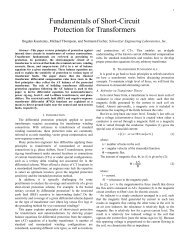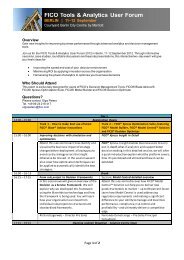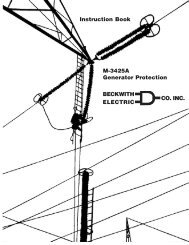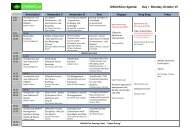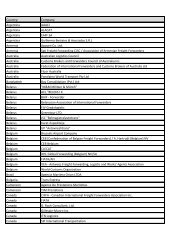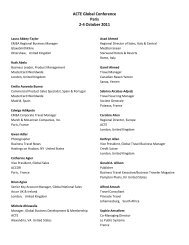TIA: Transportation Brokerage 101 Web Sampler
TIA: Transportation Brokerage 101 Web Sampler
TIA: Transportation Brokerage 101 Web Sampler
Create successful ePaper yourself
Turn your PDF publications into a flip-book with our unique Google optimized e-Paper software.
40 Chapter 8 The Broker’s Job<br />
the New Broker Kit for you to review and use as a guide.<br />
Well-drafted contracts should clearly state the responsibilities<br />
of the parties, the price, and include provisions dealing with<br />
procedures to be followed if something goes wrong.<br />
Beyond contracting, what are you looking for in a customer?<br />
Look for customers that have driver-friendly freight<br />
(e.g., perhaps shipper load consignee unload), firm delivery<br />
appointments, few or no intermediate stops and other, similar<br />
freight characteristics. It is necessary to determine the physical<br />
and the service characteristics of the freight. For example, be<br />
sure to note if the freight is classified as hazardous material or<br />
contains commodities commonly excluded by insurance coverage,<br />
as well as issues like freight destination and other similar<br />
aspects of the freight that impact operational strategies You<br />
should be aware any unusual characteristic such as temperature,<br />
altitude or stacking requirements to name a few. It is<br />
necessary to know the trends and practices of the industry you<br />
are operating in, which may include knowing if a particular<br />
destination is a “difficult” shipping area for a particular reason<br />
(e.g., season, minimal backhaul opportunities). All of the<br />
above issues can combine to help let you know if you have<br />
found a customer with freight you will be able to cover in<br />
your brokerage operations.<br />
Regardless of how you have identified a potential customer<br />
(e.g., yellow pages, networking, word of mouth), your<br />
initial contact with the customer should simply be a factfinding<br />
mission designed to allow you to collect information<br />
about its needs. If you have an opportunity and it is appropriate,<br />
ask for a facility tour and, at the least try to view the<br />
dock area. Once an understanding of the customer’s needs<br />
has been obtained, you can determine if your brokerage<br />
operation can meet those needs. If the customer’s needs can<br />
be met, a proposal should be created and presented to the<br />
potential customer. Hopefully the proposal will serve as<br />
the foundation for an agreement between the broker and the<br />
customer to provide services to the customer. If the needs of<br />
a specific customer cannot be met, keep in mind that there<br />
are always many customers in the marketplace and many of<br />
them may very well be looking for a good broker who can<br />
provide value-added services to their organization. Above<br />
all, do not try to sell something you cannot effectively<br />
accomplish but rather focus on marketing your capabilities<br />
and value-added services to the customer.<br />
Often the customer will say “I don’t deal with brokers”<br />
so ask if you can be considered a back up should one of their<br />
carriers fail to perform. If you are successful, this can open<br />
significant opportunities.<br />
Rates<br />
Once you have successfully located a potential customer,<br />
you need to arrange a time for your sales presentation. If you<br />
do everything as outlined in your sales presentation, you will<br />
gain its trust and begin to build a long-term business<br />
relationship. If you meet the customer’s requirements, you<br />
are likely to have obtained a new client.<br />
Customers may request or require that you use their<br />
existing rates for each traffic lane. If this is the case, they will<br />
likely give you a list of those rates, usually segmented by<br />
lane. This list, many times a “grid” type of schedule, should<br />
cover all possible freight lanes and should have a per-mile<br />
rate for each area. Examples of lane price structures or rate<br />
grids can be found in the appendix to this text.<br />
Even though the customer has preexisting rates, it might<br />
raise or lower rates. Always plan your negotiations with this in<br />
mind. Investigate whether it is willing to give you a little<br />
higher rate for some lanes, if you are willing to charge a little<br />
less for other lanes. For example, if you have a large, wellpaying<br />
customer in Arizona that has as many loads as you can<br />
handle, negotiate with the customer’s existing rates to lower<br />
its rate from Point A to Arizona. This will help you to secure<br />
a contract for those lanes. By dropping a rate on one lane, the<br />
customer may be willing to increase your rate on other lanes.<br />
Do not negotiate to haul loads you cannot handle unless<br />
you have chosen some other brokers to work with you on a<br />
referral basis. If you are not experienced moving that type of<br />
freight, are not aware of any carriers with that type of equipment,<br />
or cannot handle the rate, then find another sales<br />
lead for your trucks and get referral money on the account.<br />
You are likely to run across some areas where carriers control<br />
the market and you cannot haul the freight and make a<br />
profit. Do not try to compete for freight if you cannot move<br />
it for a profit. Do, however, call brokerage firms and agents<br />
offering referral fees for freight. Just because you cannot<br />
arrange to transport a load for a profit, it does not mean a<br />
large firm or an agent in a different location cannot make a<br />
profit on the same load. You will earn money on every load<br />
referred.<br />
Some customers will expect you to quote rates to them.<br />
In most cases the customer has budgeted expenses (see sample<br />
budget, Appendix 3) with current transportation costs in<br />
mind. If this is the case, use the rate grid and calculate your<br />
rates based on the following variables:<br />
1. Does the customer have good credit?<br />
2. What are the average rates for similar types of freight<br />
moving regularly in the same or similar lanes?<br />
3. What rates can I provide below the average (Where do<br />
I have a competitive advantage)?<br />
4. What rates must I price above the average to cover my<br />
cost?<br />
5. Are there lanes I want to be excluded from or that<br />
do not make business sense for me to be involved in<br />
regularly?<br />
6. What accessorial (add-on charges like detention, etc.)<br />
charges are involved?<br />
7. How many loads per month should I be hauling?<br />
8. What formula does the customer use for Fuel<br />
Surcharges?



